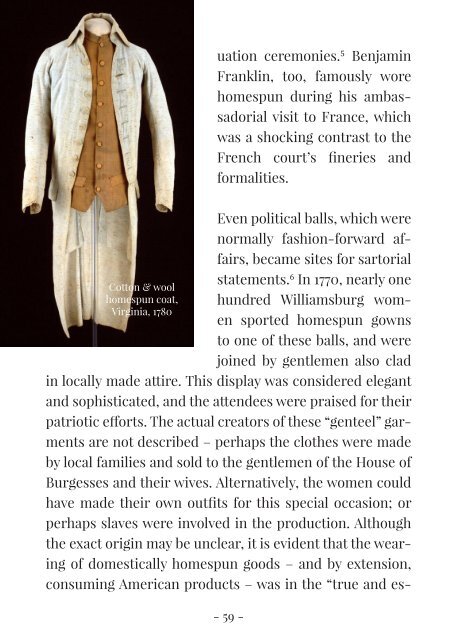The Fleece of Their Flock: Homespun & the American Identity
This interdisciplinary thesis project was researched, written, and designed by Jessica Vodnik and submitted in fulfillment of the Honors Senior Capstone requirement for the DePaul University Honors Program. Please do not copy, reproduce, or distribute without permission. Dr. Amy Tyson, Director, American Studies Dr. John Burton, Second Reader, History Undergraduate Honors Senior Thesis DePaul University, Chicago, IL May 10, 2015
This interdisciplinary thesis project was researched, written, and designed by Jessica Vodnik and submitted in fulfillment of the Honors Senior Capstone requirement for the DePaul University Honors Program. Please do not copy, reproduce, or distribute without permission.
Dr. Amy Tyson, Director, American Studies
Dr. John Burton, Second Reader, History
Undergraduate Honors Senior Thesis
DePaul University, Chicago, IL
May 10, 2015
You also want an ePaper? Increase the reach of your titles
YUMPU automatically turns print PDFs into web optimized ePapers that Google loves.
uation ceremonies. 5 Benjamin<br />
Franklin, too, famously wore<br />
homespun during his ambassadorial<br />
visit to France, which<br />
was a shocking contrast to <strong>the</strong><br />
French court’s fineries and<br />
formalities.<br />
Cotton & wool<br />
homespun coat,<br />
Virginia, 1780<br />
Even political balls, which were<br />
normally fashion-forward affairs,<br />
became sites for sartorial<br />
statements. 6 In 1770, nearly one<br />
hundred Williamsburg women<br />
sported homespun gowns<br />
to one <strong>of</strong> <strong>the</strong>se balls, and were<br />
joined by gentlemen also clad<br />
in locally made attire. This display was considered elegant<br />
and sophisticated, and <strong>the</strong> attendees were praised for <strong>the</strong>ir<br />
patriotic efforts. <strong>The</strong> actual creators <strong>of</strong> <strong>the</strong>se “genteel” garments<br />
are not described – perhaps <strong>the</strong> clo<strong>the</strong>s were made<br />
by local families and sold to <strong>the</strong> gentlemen <strong>of</strong> <strong>the</strong> House <strong>of</strong><br />
Burgesses and <strong>the</strong>ir wives. Alternatively, <strong>the</strong> women could<br />
have made <strong>the</strong>ir own outfits for this special occasion; or<br />
perhaps slaves were involved in <strong>the</strong> production. Although<br />
<strong>the</strong> exact origin may be unclear, it is evident that <strong>the</strong> wearing<br />
<strong>of</strong> domestically homespun goods – and by extension,<br />
consuming <strong>American</strong> products – was in <strong>the</strong> “true and es-<br />
- 59 -


